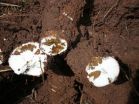(Press-News.org) Diseased trees in forests may be a significant new source of methane that causes climate change, according to researchers at the Yale School of Forestry & Environmental Studies in Geophysical Research Letters.
Sixty trees sampled at Yale Myers Forest in northeastern Connecticut contained concentrations of methane that were as high as 80,000 times ambient levels. Normal air concentrations are less than 2 parts per million, but the Yale researchers found average levels of 15,000 parts per million inside trees.
"These are flammable concentrations," said Kristofer Covey, the study's lead author and a Ph.D. candidate at Yale. "Because the conditions thought to be driving this process are common throughout the world's forests, we believe we have found a globally significant new source of this potent greenhouse gas."
The estimated emission rate from an upland site at the Yale forest is roughly equivalent to burning 40 gallons of gasoline per hectare of forest per year. It also has a global warming potential equivalent to 18 percent of the carbon being sequestered by these forests, reducing their climate benefit of carbon sequestration by nearly one-fifth.
"If we extrapolate these findings to forests globally, the methane produced in trees represents 10 percent of global emissions," said Xuhui Lee, a co-author of the study and Sara Shallenberger Brown Professor of Meteorology at Yale. "We didn't know this pathway existed."
The trees producing methane are older—between 80 and 100 years old—and diseased. Although outwardly healthy, they are being hollowed out by a common fungal infection that slowly eats through the trunk, creating conditions favorable to methane-producing microorganisms called methanogens.
"No one until now has linked the idea that fungal rot of timber trees, a production problem in commercial forestry, might also present a problem for greenhouse gas and climate change mitigation," said Mark Bradford, a co-author and Assistant Professor of Terrestrial Ecosystem Ecology at F&ES.
Red maple, an abundant species in North America, had the highest methane concentrations, but other common species, including oak, birch and pine were also producers of the gas. The rate of methane emissions was 3.1 times higher in the summer, suggesting that higher temperatures may lead to increasing levels of forest methane that, in turn, lead to ever-higher temperatures.
"These findings suggest decay in living trees is important to biogeochemists and atmospheric scientists seeking to understand global greenhouse gas budgets and associated climate change," said Covey.
###
The other co-authors of the paper, "Elevated Methane Concentrations in Trees of an Upland Forest," are Stephen Wood, a Ph.D. student at Columbia University, and Robert Warren, former postdoctoral researcher at Yale and now an assistant professor at Buffalo State (SUNY). The paper can be viewed at www.agu.org/pubs/crossref/pip/2012GL052361.shtml.
END
ST. LOUIS, MO, August 7, 2012— An international research collaboration recently demonstrated progress in protecting cassava against cassava brown streak disease (CBSD), a serious virus disease, in a confined field trial in Uganda using an RNA interference technology. The field trial was planted in November 2010 following approval by the National Biosafety Committee of Uganda. The plants were harvested in November 2011 and results were published in the August 1, 2012 issue of the journal Molecular Plant Pathology . These results point researchers in the right direction ...
New Rochelle, NY, August 7, 2012—The global market value of Alzheimer's disease therapeutics could soar to the $8 billion range once therapeutics are approved that actually change the course of the disease, reports Genetic Engineering & Biotechnology News (GEN). The current therapeutic market is valued at $3 to $4 billion, shared among drugs that temporarily delay disease progression or address the symptoms but do not alter the underlying disease, according to a recent issue of GEN.
"Despite all the research on amyloid plaques and neurofibrillary tangles there is still ...
If you're looking for information on the evolution and function of jaws, University of Notre Dame researcher Matt Ravosa is your man.
His integrative research program investigates major adaptive and morphological transformations in the mammalian musculoskeletal system during development and across higher-level groups. In mammals, the greater diversification and increasingly central role of the chewing complex in food procurement and processing has drawn considerable attention to the biomechanics and evolution of this system. Being among the most highly mineralized, and ...
The 14 years of wildlife studies in and around Madagascar's Ranomafana National Park by Sarah Karpanty, associate professor of wildlife conservation at Virginia Tech's College of Natural Resources and Environment, and her students are summarily part of a paper on biodiversity published July 25 by Nature's Advanced Online Publication and coming out soon in print.
As human activities put increasing pressures on natural systems and wildlife to survive, 200 scientists around the world carved up pieces of the puzzle to present a clearer picture of reality and find ways to mitigate ...
LA JOLLA, CA----It was long thought that methylation, a crucial part of normal organism development, was a static modification of DNA that could not be altered by environmental conditions. New findings by researchers at the Salk Institute for Biological Studies, however, suggest that the DNA of organisms exposed to stress undergo changes in DNA methylation patterns that alter how genes are regulated.
The scientists found that exposure to a pathogenic bacteria caused widespread changes in a plant's epigenetic code, an extra layer of biochemical instructions in DNA that ...
Ann Arbor, Mich. — Significantly more children get health insurance coverage after increases in federal matching funds to states for Medicaid and the Children's Health Insurance Program (CHIP), according to new research from the University of Michigan.
The research, published Monday in the journal Health Affairs, showed that a 10-percentage-point increase in the federal match for Medicaid and CHIP, similar to the increase that occurred with the American Reinvestment and Recovery Act, is associated with an increase of 1.9 percent in the number of children enrolled in ...
Infrared satellite imagery from shows how cold cloud top temperatures are in a tropical cyclone, and recent imagery from NASA's Aqua satellite shows the cloud-top temperatures have been warming in Tropical Storm 13W. Warming cloud top temperatures indicate less strength, and Tropical Storm 13W is weakening.
NASA's Aqua satellite passed over Tropical Storm 13W on August 7 at 0253 UTC. The Atmospheric Infrared Sounder (AIRS) instrument that flies onboard Aqua captured an infrared image of the storm's cloud temperatures that showed very limited strong thunderstorms make ...
Tropical Storm Haikui is headed for landfall in southeastern China, and NASA's Aqua satellite caught a stunning image of its size and its ragged, but wide eye when it was a typhoon earlier today, August 7. As a result of interaction with land, Haikui has weakened to a tropical storm.
When NASA's Aqua satellite passed over Typhoon Haikui on August 6, 2012 at 12:35 a.m. EDT the Moderate Resolution Imaging Spectroradiometer (MODIS) instrument onboard captured an image of the storm as it was approaching China. The MODIS image clearly showed Haikui's ragged and elongated eye ...
Satellite data helps forecasters see where the strongest part of a tropical cyclone is located, and NASA's Aqua satellite noticed Ernesto's strongest storms were on the eastern side yesterday. Today, strong storms surround Ernesto's center.
A visible image of Tropical Storm Ernesto approaching Central America was captured by the Moderate Resolution Imaging Spectroradiometer (MODIS) instrument that flies onboard NASA's Aqua satellite. In an image captured on August 6, 2012 at 1840 UTC (2:40 p.m. EDT), the strongest thunderstorms appeared to be on the northern and eastern ...
Conflict-of-interest statements made by physicians and scientists in their medical journal articles after they had been allegedly paid by pharmaceutical manufacturers as part of off-label marketing programs are often inadequate, highlighting the deficiencies in relying on author candidness and the weaknesses in some journal practices in ensuring proper disclosure, according to a study by international researchers published in this week's PLOS Medicine. Off-label marketing is the promotion by a manufacturer of a drug for use in a condition or age group, or in a dose or form ...





